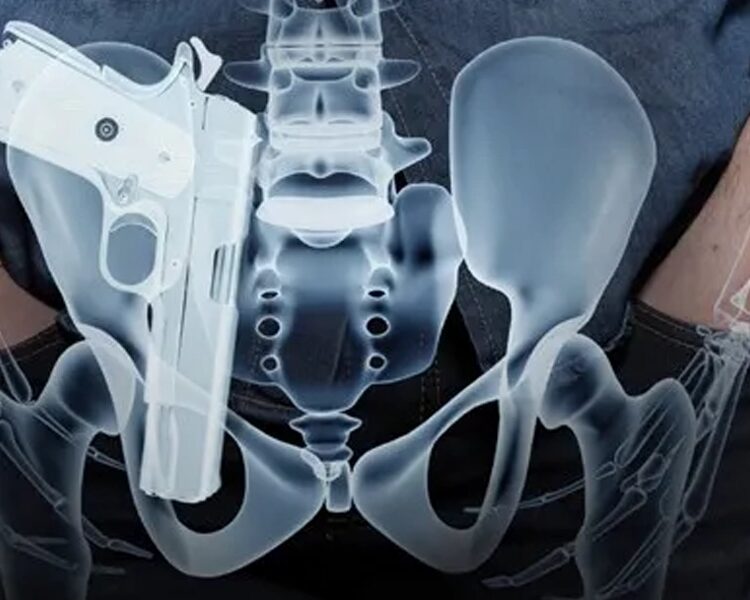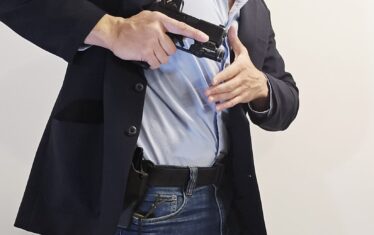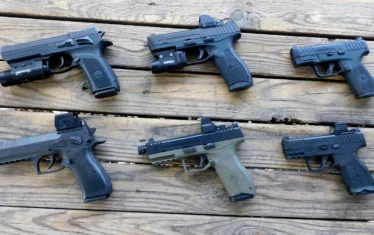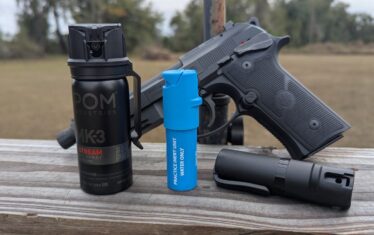Appendix carry becomes more popular every year. I know many folks who have switched from “four o’clock” to “one o’clock” and never looked back. Others base their carry position on situation, attire, or both. That appendix carry is here to stay seems undeniable, yet many people still disparage it, usually citing persistent myths that have long been debunked.
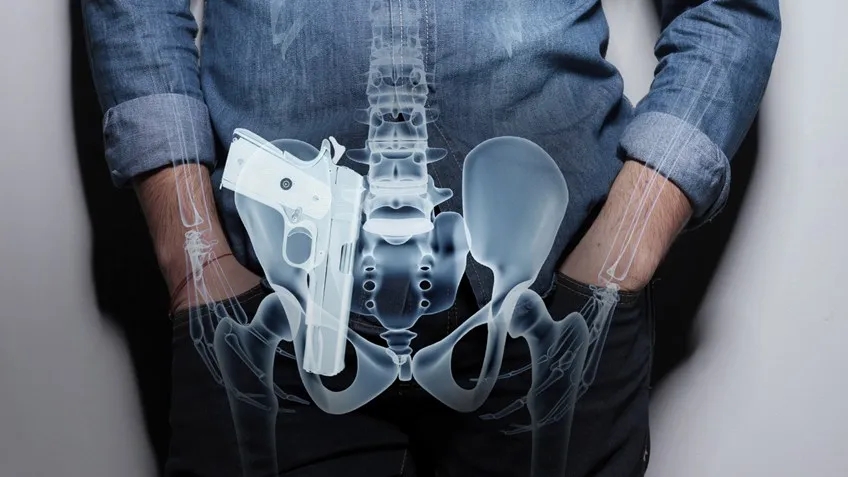
So, with that in mind, let’s look briefly at the appendix carry technique, what it is, and how to do it properly. We’ll address two prominent myths along the way and advise you on how to set yourself up to make appendix carry a viable option. We’ll even look at body types, the challenges of which are something your humble correspondent can speak to firsthand.
What is Appendix Carry?
Simply put, appendix carry is carrying your firearm at approximately the one o’clock position, relative to your belt buckle. The gun is placed over your appendix, thus the name.
Appendix carry is considered a concealed carry technique, though you can carry openly if you choose. But this article is about concealed carry, so we’ll stick to that. Appendix carry’s association with concealed carry has led to it being sometimes referred to as “Appendix Inside the Waistband” carry, or AIWB carry.
Appendix Carry Myths
Two prominent myths persist about appendix carry, despite its growing popularity.
Appendix carry critics point to perceived safety problems related to the gun’s position relative to certain sensitive body parts. The first sensitive body part is obvious, especially for males. I admit to occasional wariness regarding that particular concern.
Second, the femoral artery seems particularly vulnerable, considering the direction an appendix-carried gun points. A gunshot wound to that, or any artery, is likely a death sentence.
But are those concerns valid? Well, yes and no. We should all know that improperly handled firearms are dangerous. But the four safety rules exist for a reason. If you follow those rules and couple them with proper appendix carry technique, carrying at the one o’clock position is no more hazardous than any other place. We’ll address those simple techniques below, but let’s dispense with general information before getting specific.

Advantages and Disadvantages of Appendix Carry
Every concealed carry method has its pros and cons. Appendix carry is no different. Let’s start with the advantages:
- Concealability: An appendix-carried firearm is generally easier to conceal than a gun stuck out on your hip. Even a shoulder holster creates a bulge, no matter how slim the firearm. But the appendix method is easily covered up by a loose T-shirt. Heavier garments make it even more so. Appendix carry also allows you to carry a larger firearm without printing than hip carry. There’s a reason many of us have “summer guns,” and “winter guns.” Appendix carry can all but eliminate that consideration.
- Easy accessibility: Appendix draw comes more naturally than reaching for the four o’clock. Try it. It’s a more natural motion in line with how your arms work. So is pulling up your shirt with your off hand. Hip carry requires clearing your covering garment and drawing with the same hand. You can do that with appendix carry too, but it probably won’t be necessary. Not to mention that you can also cross-draw if your dominant arm is injured or pinned. That’s not an option when the gun’s on your hip.
- Easier retention: “Gun grabs,” where someone snatches your pistol from its holster, aren’t common. But they do happen. Appendix carry almost completely precludes a gun grab. First, you can see any such thing coming. Second, an appendix-carried gun is much easier to defend than a hip-carried gun, which is also vulnerable from the rear. Of course, nothing beats proper situational awareness for firearm retention.

As noted, there is no perfect carry position. Concealed carry is a system of compromises in which we all try to maximize the good, creating a method that works for us. The disadvantages of appendix carry include:
- Discomfort: Appendix carry can be uncomfortable, especially for certain body types. This discomfort can be mitigated by selecting the right firearm, the right holster, and the right belt. Discomfort is also a problem for those of us who are, shall we say, “less svelte.” More on that in a moment.
- The inability to hide your draw: Some situations may allow a hip carrier to draw while supposedly reaching for a wallet. Or even just unobtrusively turning their body a certain way. Appendix carry makes that more difficult. When you pull up your shirt and reach for your pistol, it’s pretty obvious what’s going on.
Making it Comfortable
The proper equipment can ease, and even eliminate appendix carry discomfort. Like anything firearms-related, successful appendix carry depends on having the right tools for the job. Let’s dig into that.
Get A Good Holster
Simply put, appendix holsters are made for appendix carry. Hip holsters are not.
Many people try to repurpose their hip holsters for appendix carry, but it rarely works. Your one o’clock body shape is different from your four o’clock body shape. And hip holsters require a different cant than appendix holsters.
The right holster material helps too. A full Kydex holster can bite and cut. Ask me how I know. But a hybrid holster with a Kydex shell on a leather or neoprene backing helps with that.
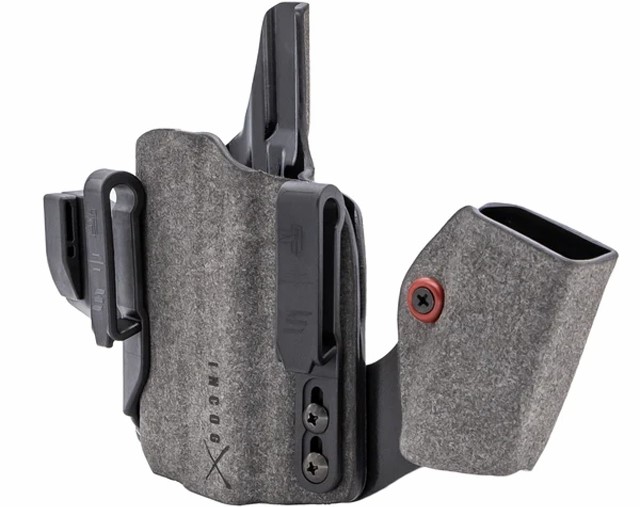
Another advantage to appendix carry, as I see it, is directly related to holsters. If I want to pack an extra magazine while carrying on my hip, I can either attach a separate mag carrier on my left side or I can stick the mag in my pocket. I go back and forth, based on my attire.
Many appendix holsters feature an attached mag carrier, or at least have that option. The Safariland Incog X IWB Holster is a great example. Like the gun, reaching for an extra mag at the appendix is very natural.
Spring for a Good Gun Belt
Likewise, a proper gun belt is critical. If you’ve carried for any length of time, you’ve likely learned that standard belts often don’t hold up like they should, whether on the hip or at the appendix. Only a dedicated gun belt will stop the sag, thus minimizing the discomfort once you find the right spot.
One trick to appendix carry is moving your belt buckle to the side to reduce bulk near the gun. I’ve found that it also keeps the buckle out of my way when I reach for my gun. Not required, but something you might try.
If you’ve never used a real gun belt, you need to fix that. I used crappy belts for years. I’m cheap, what can I say? But I finally spent the extra money and now I won’t go back. It makes that much of a difference.
Body Type Matters
I’m a pretty big boy, and not always in the best places. I explored appendix carry, but frankly, my gut wouldn’t allow it. I even tried a so-called “fat guy” holster, but it was very uncomfortable. At least for me. So, I’ve carried on my right hip forever. I still do that most of the time.
But occasionally, I want to appendix carry. I solved the problem with a bellyband holster coupled with a subcompact Ruger Max 9 pistol. I had to try a few different things, what with finding the right pistol and the right placement, but it was worth it. It’s still not perfect, but after a few minutes, I hardly know it’s there. I now have a viable appendix option that I can run until this latest diet works its magic. Mmmm-hmmm.
My body shape also means I can’t really carry larger guns at the appendix. I just can’t do it. Skinny folks’ appendix guns can ride higher, making sitting easier. I can’t do that. I’m also aware of whose fault that is. So, for now at least, I’m limited to smaller guns like the Max 9.
Trial and Error
Learning to appendix carry requires some trial and error. You’ll have to find out where the gun is most comfortable for you while standing and sitting. Most people carry right around the one o’clock position, but I’ve seen people go wider and even true centerline. Your gun’s length and holster construction will dictate much of this.
I could appendix carry my Beretta 92FS if I never had to sit down. But that’s not realistic, especially as much as we drive. I found that driving comfortably was the hardest obstacle to overcome. So, test your firearm of choice while standing, sitting, bending over, and anything else you might normally do. Then go with the gun that works best for you.
Folks in better shape than I will find they likely have more options. It’s good to be healthy!
Proper Appendix Carry Techniques
Now that we’ve dealt with the general stuff and gotten ourselves properly equipped, let’s look at how the right technique makes appendix carry just as safe as any other method.
Holstering is the point most likely for trouble when appendix carrying. The potential certainly exists when drawing, but proper trigger discipline minimizes that risk.
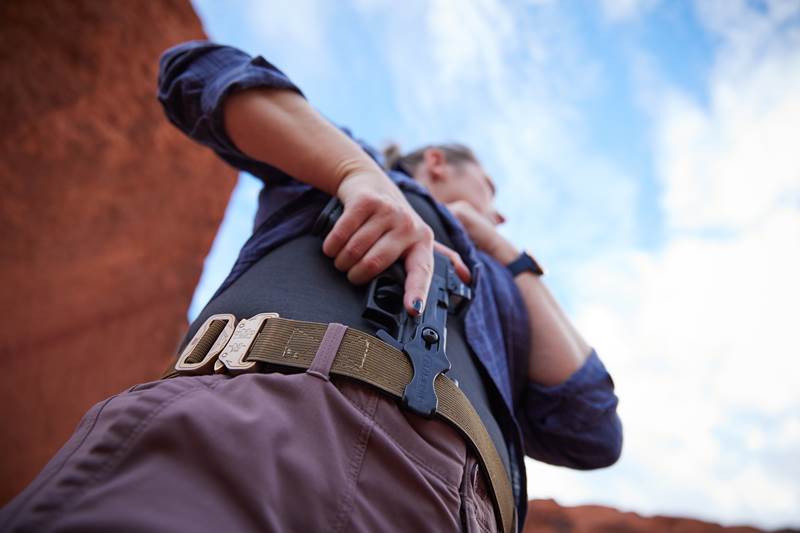
But properly holstering your appendix-carried firearm is simple and only requires a bit of thought. Taking time to think about your holstering steps is a good idea no matter where you carry your sidearm, but it’s particularly important with appendix carry because of where your firearm points when being holstered. That’s when you run the highest risk of a foreign object, or even part of your shirt, being inserted into the trigger guard, possibly facilitating a negligent discharge (ND).
For this reason, many instructors recommend a hammer-fired double/single action firearm, or a gun with an external safety, for appendix carry. It’s not required, and proper training can mitigate the risk, but it’s worth mentioning. I purposely got the safety-equipped Max 9 for that reason, and I wedge my thumb under it as I holster the gun. You can also hold the hammer down on a DA/SA pistol.
I saw a suggestion to do a mental “hard break” before holstering. That’s when you go into administrative mode, engaging the safety or applying pressure to the hammer. That break also prompts your holstering process:
- Step 1: Step back with your strong side leg. It doesn’t have to be exaggerated. Just a normal step distance.
- Step 2: Lean back. Again, it doesn’t have to be ridiculous, but you’re working to get the gun’s point of aim in front of you. Maybe do a little extra without hurting yourself.
- Step 3: Look the gun all the way into the holster. Go slow. It won’t take that long either way.
That’s it. If you do that consistently, your chance of an ND while holstering goes way down.
You Can Appendix Carry Too
Appendix carry is literally no more dangerous than any other carry method, assuming you do it correctly. It also has certain advantages, as we discussed. I still carry mostly on my hip, but I’m glad I can appendix carry when I choose. For me, that’s when I want to be more discreet than usual.
The trick is understanding what you’re doing and why you’re doing it. That enables you to equip yourself properly and makes you want to do things correctly. Appendix carry is no different.
If you’ve been resistant to appendix carry, maybe give it another look if you think it serves you. I had all but given up on appendix carry, but now I employ it several times per week. It’s one more cog in my self-defense system. Maybe it will be for you, too.





